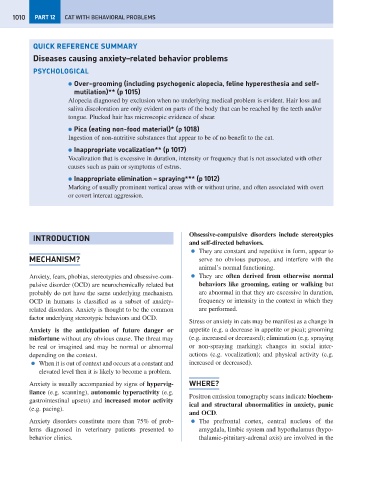Page 1018 - Problem-Based Feline Medicine
P. 1018
1010 PART 12 CAT WITH BEHAVIORAL PROBLEMS
QUICK REFERENCE SUMMARY
Diseases causing anxiety–related behavior problems
PSYCHOLOGICAL
● Over-grooming (including psychogenic alopecia, feline hyperesthesia and self-
mutilation)** (p 1015)
Alopecia diagnosed by exclusion when no underlying medical problem is evident. Hair loss and
saliva discoloration are only evident on parts of the body that can be reached by the teeth and/or
tongue. Plucked hair has microscopic evidence of shear.
● Pica (eating non-food material)* (p 1018)
Ingestion of non-nutritive substances that appear to be of no benefit to the cat.
● Inappropriate vocalization** (p 1017)
Vocalization that is excessive in duration, intensity or frequency that is not associated with other
causes such as pain or symptoms of estrus.
● Inappropriate elimination – spraying*** (p 1012)
Marking of usually prominent vertical areas with or without urine, and often associated with overt
or covert intercat aggression.
Obsessive-compulsive disorders include stereotypies
INTRODUCTION
and self-directed behaviors.
● They are constant and repetitive in form, appear to
MECHANISM? serve no obvious purpose, and interfere with the
animal’s normal functioning.
Anxiety, fears, phobias, stereotypies and obsessive-com- ● They are often derived from otherwise normal
pulsive disorder (OCD) are neurochemically related but behaviors like grooming, eating or walking but
probably do not have the same underlying mechanism. are abnormal in that they are excessive in duration,
OCD in humans is classified as a subset of anxiety- frequency or intensity in the context in which they
related disorders. Anxiety is thought to be the common are performed.
factor underlying stereotypic behaviors and OCD.
Stress or anxiety in cats may be manifest as a change in
Anxiety is the anticipation of future danger or appetite (e.g. a decrease in appetite or pica); grooming
misfortune without any obvious cause. The threat may (e.g. increased or decreased); elimination (e.g. spraying
be real or imagined and may be normal or abnormal or non-spraying marking); changes in social inter-
depending on the context. actions (e.g. vocalization); and physical activity (e.g.
● When it is out of context and occurs at a constant and increased or decreased).
elevated level then it is likely to become a problem.
Anxiety is usually accompanied by signs of hypervig- WHERE?
ilance (e.g. scanning), autonomic hyperactivity (e.g.
Positron emission tomography scans indicate biochem-
gastrointestinal upsets) and increased motor activity
ical and structural abnormalities in anxiety, panic
(e.g. pacing).
and OCD.
Anxiety disorders constitute more than 75% of prob- ● The prefrontal cortex, central nucleus of the
lems diagnosed in veterinary patients presented to amygdala, limbic system and hypothalamus (hypo-
behavior clinics. thalamic-pituitary-adrenal axis) are involved in the

